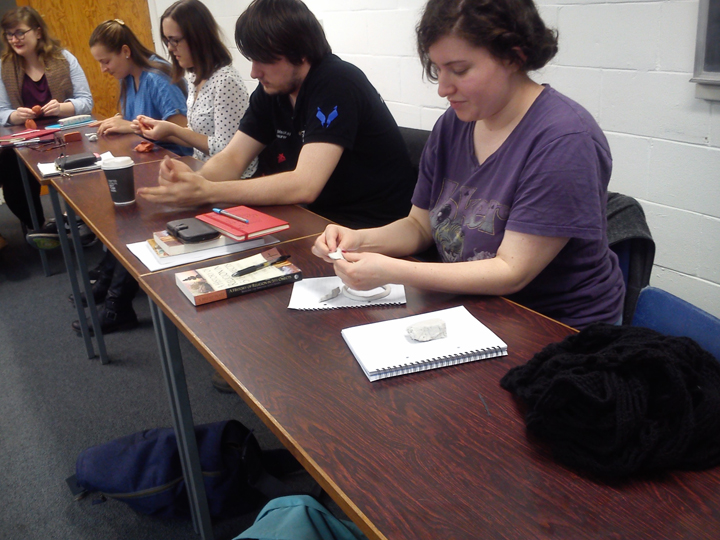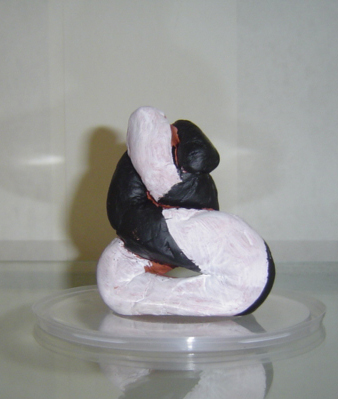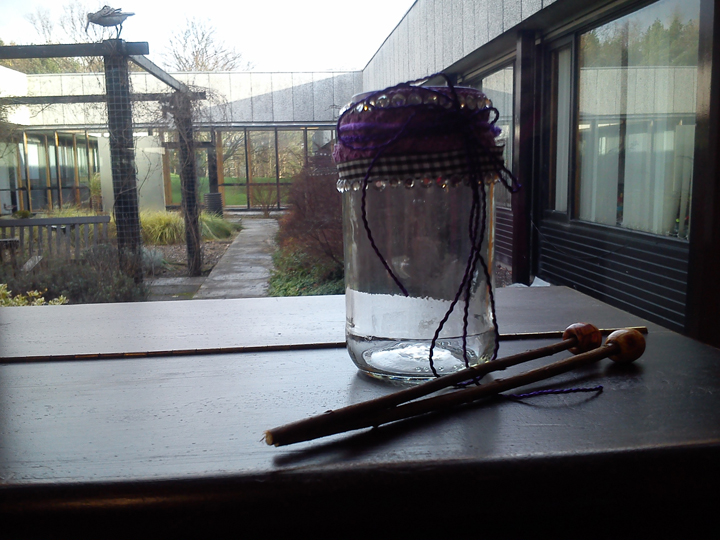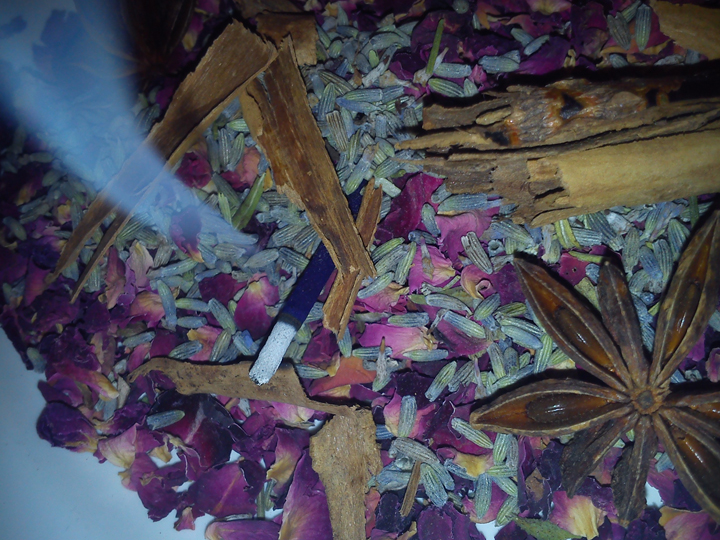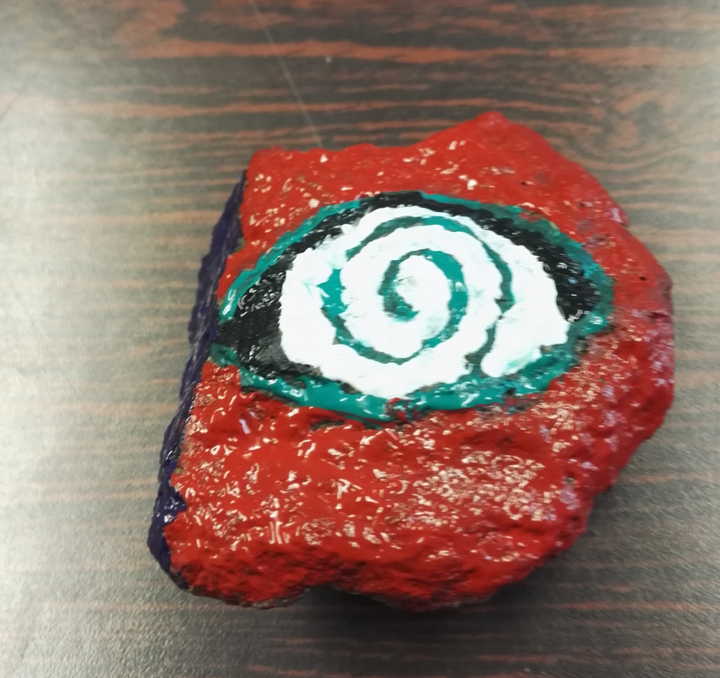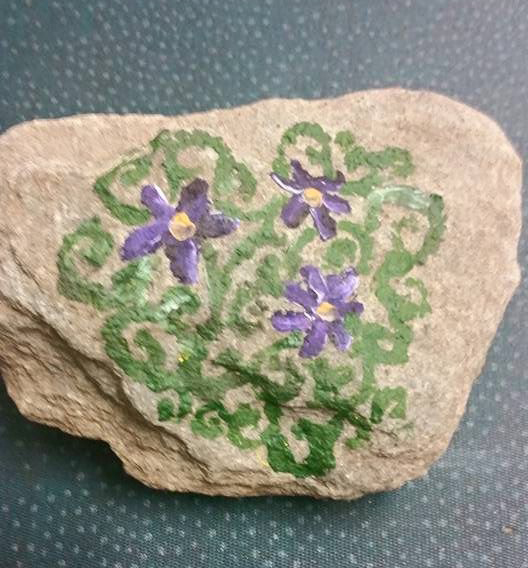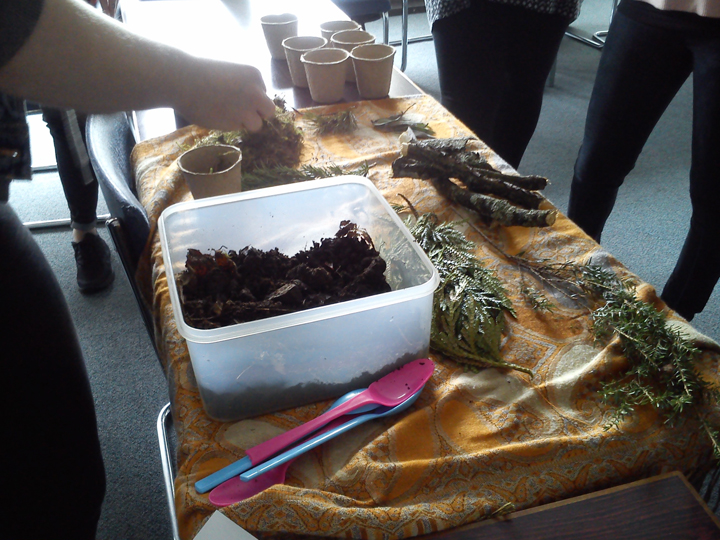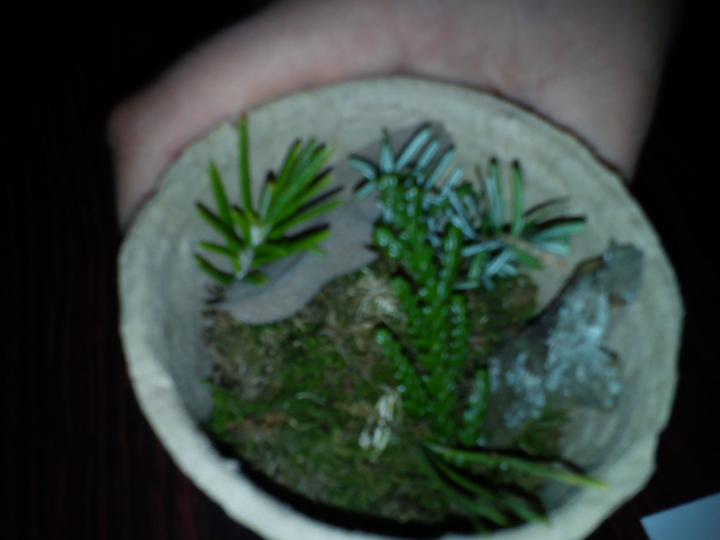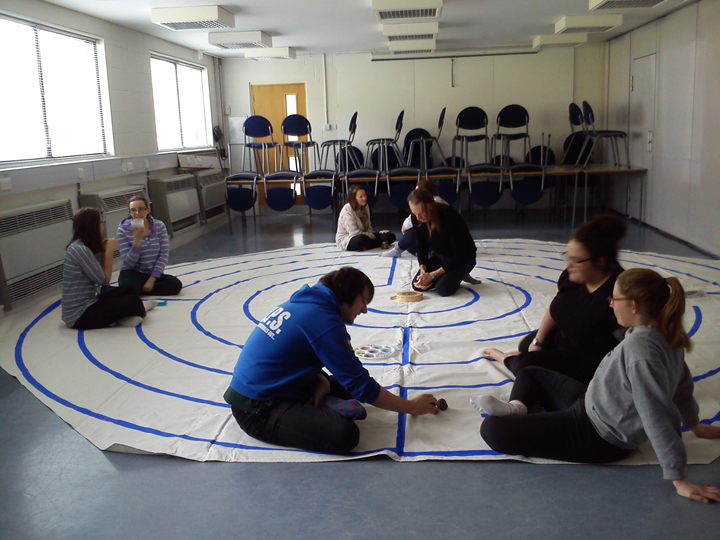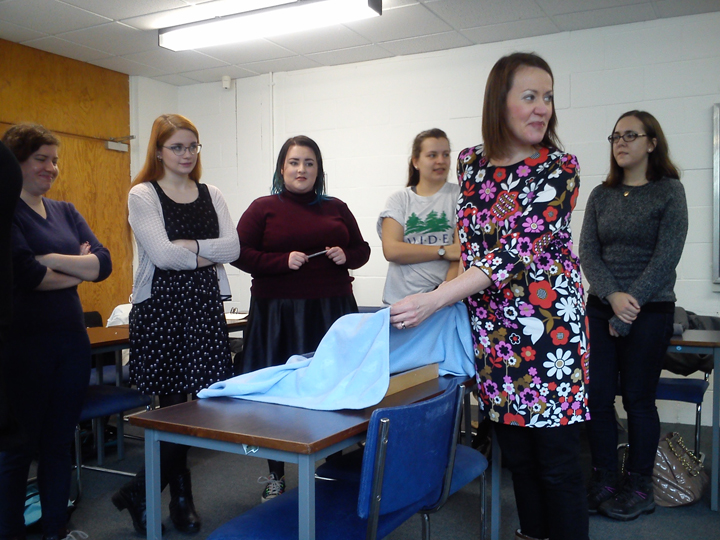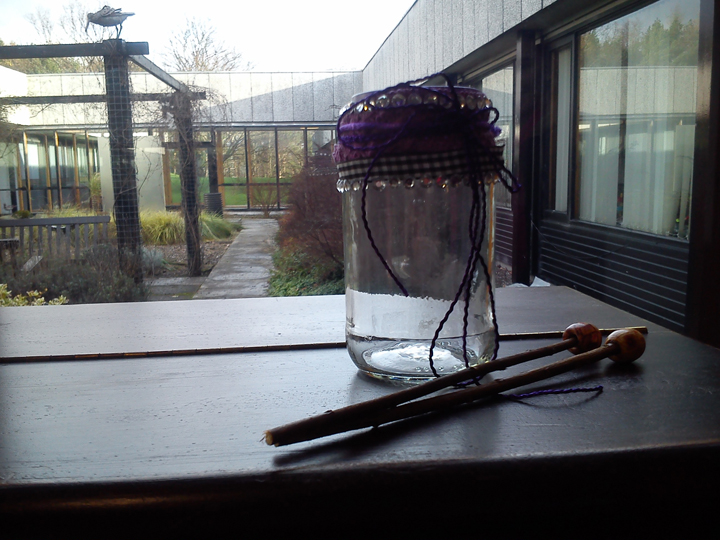
Blurring the educational lines? Material religion in the undergraduate classroom
Francis Stewart explores the pedagogical possibilities of teaching material religions as a way of differently engaging with the concept “religion.” Using her experiences in a recent undergraduate course at the University of Stirling, Stewart argues that an embodied, sensory-based approach to material religions helps students approach theoretical and methodological tenets in different, nuanced, more embodied ways, ultimately yielding a context in which, for students and professors alike, the classroom can come to function as a sacred space.
Socrates said that education is the kindling of a flame, not the filling of a vessel [i]. This is a very visceral, materially grounded view of the purpose of education and learning. An approach of filling a vessel implies that the students are empty and purposeless until supplied with knowledge by the more learned scholar and that there is only so much they are capable of taking on. A kindling of a flame, however, takes the view that the raw material – the passion, the thirst for knowledge – is already present and the role of the educator is to spark it off and help it grow until it can sustain itself. It removes the limits of knowledge and instead opts for an approach that continues to consume, to grow and to strip away the unhelpful or unnecessary. The Socratic method is one in which a teacher, by asking leading questions, guides students to discovery. It is a dialectical method that employs critical inquiry to undermine the plausibility of widely-held doctrine [ii]. The Socratic method is one that is often employed in the classrooms of higher education, but increasingly, it seems for the purpose of filling a vessel rather than kindling a flame, except in those few students we see as somehow arbitrarily exceptional. This blog posting is asking if we can use material religion not just to engage with the very concept of ‘religion’ (amongst others) but as a means of re-orientating ourselves and our pedagogies.
It is therefore important to reflect briefly upon what is meant in this posting by both pedagogy and material religion. I arrived at higher education via a career in teaching religious studies in UK high schools (in the UK a high school runs from the age of 11 to 18). I had, therefore, been trained to think about pedagogy from a range of perspectives and developed my own approach based on a synthesis of the theories of Paulo Freire and Lev Vygotsky who both argue that education should have a dialectical relationship that is articulated in praxis [iii]. Building upon both, I would argue that learning / educational pedagogy is a socially constructed process that relies upon an informed and informative collaborative experience that results in both the educator and the student learning something. In constructing a recent religion course at the University of Stirling I deliberately set it up so that space was created for both the students and I to reflect on what we were learning from each other, to ensure that I was made as vulnerable as them in what I revealed about myself and how I engage with the material objects. When the students devised activities for their peers I took part in them and wrote a reflection for them in the same way they had to reflect on their work for me. I also gave the students ownership of what was made public on Twitter from their work. They would as a cohort select which images they wanted to be placed on Twitter and would then excitedly tell me the following week who had responded, what had been commented. They were never more pleased than when Brent Plate commented or liked their work.
Material religion is something that had been embedded within my own research and writings, but had only marginally been an element of my teaching until I created this course, an honours level undergraduate course entitled ‘Religion, Theology and Postmodernity.’ It was intended to focus on an understanding of contemporary postmodern culture in regards to its relationship with the divine, the sacred and the ineffable. It explored different ways in which individuals and groups have either embraced or reacted to the post-modern ideology of religious, moral, cultural and political pluralism. An emphasis was placed on material religion as a means of understanding the relationship between religion and postmodernity.
As someone who conducts insider participant research on punk and anarchy subcultures I had focused on the embodied nature of tattoos, clothing, dancing, flyers, fanzines and protests but had limited my teaching on them to words and pictures. However I had grown increasingly frustrated at the limitation of academia in its slavish devotion to ‘the word’, only sometimes supplemented by an image. As someone who is severely dyslexic words are something that both enchant and frustrate, but ultimately remain outside of my natural grasp. In attending the material religion panels at the 2015 American Academy of Religion Annual Meeting I was presented with maps, artefacts, websites that one could zoom in on and retrieve video clips, soundscapes, photographs and people telling their own stories. I immediately latched onto this as a way to break the focus on the written word as the dominant educational tool. I looked further into the field and saw the potential within it for widening access and connecting classroom education with the everyday world in a new way, but also noted that nothing was written on how to do so. Therefore this blog posting is offered as a way of moving the field in that direction, in broadening how we teach such a vital subject, as a way of showing the limitless possibilities of educational praxis even in tightly controlled environments and institutions.
Figure 1: Some of the students taking the material religion course at the University of Stirling, Spring Semester 2016. Here they are making their own symbol using air drying clay.
As educators we spend hours deciding what we are going to teach, what we want students to know, to be able to do and how we can quantify those hours – especially with the TEF (Teaching Excellence Framework, conceived, implemented and monitored by the UK government and linked to funding allowance) now being developed in the UK. Seldom do we perhaps give any thought to the material space we are working in when we educate, beyond the concerns of enough seats (or students), technology working and so on. Literature on the undergraduate classroom refers to the classroom in relation to the activities or power relations with it, not to the actual space, furniture and walls [iv]. The classroom or lecture theatre is just the space we inhabit for that period of time. Is it the same for our students? When I was asked to create an honours level course at the University of Stirling I began by asking the students what the classroom itself meant to them. These were some of the replies:
“It is somewhere I feel a little giddy entering, as it is where things usually come together.” Scott
“It is my refuge, my place away from everything else and yet it doesn’t exclude the everyday. I feel my body relax as I sit in the seats and I love the feeling when I get my notebook out and open it on the desk.” Kayla
“I like the weight of the door as you push it to go in, it’s an effort but it takes you somewhere. You get to enter something full of possibility.” Arden [v]
Of course there were also the expected comments of ‘it’s where you learn’. However it is interesting to note the type of language that some of the students were using, it could be argued to be ‘religious’ in nature. Their answers tie in with what Brent Plate notes about the nature of being ½: that we seek to unite our wholeness to make ourselves complete, through the senses and through our interaction with the world around us [vi]. That is, I would argue, what these students are doing within the classroom, which raised an interesting question: could a course be designed that took into account their view of the classroom as either a liminal or a potentially sacred space? And how should it be taught? The reminder of this blog focuses on the resultant material religion course that was created and taught on the basis of trying to answer that question. It will include photos, assessment notes and quotes from students.
First though, a brief note on the classroom context and student demographics. At Stirling honours level courses are optional and so tend to be groups between 10 and 30 students taught in teaching labs rather than lecture theatres. The lecturer can determine the shape of the tables but not the remainder of the layout of the room (the screens, projectors and speakers are all fixed to the walls or ceilings). This course had 14 students signed up to take it as an option module and a further 3 students auditing it. The students were a range of backgrounds including UK, EU, American and Canadian and ranged in age from 20 to their early 60s. Religion is not offered as a single honours degree so all the students combine it with another subject. Within this cohort it was predominantly education (this is the most popular combination at Stirling, with most students then going on to pursue a career in state education) followed by philosophy, English literature, sociology and history.
The course
Practically speaking, the course was twelve weeks, with three hours per week teaching time. One of those hours was dedicated to a practical sense-based approach. The other two hours (on a different day) were a more traditional class that engaged with key texts, theory and case studies. The purpose of the one hour practical approach was full sensory engagement so students were not allowed to take notes or engage in typical ‘student’ classroom behaviour. They were also encouraged to have their phones, tablets and other devices that they felt were a key part of themselves on and to use them to record video or take photographs of what they were doing, live tweet their activities, or Instagram it. The practise of coming in and taking notebooks and pens out was so ingrained that they automatically did this for a number of weeks and had to be reminded to put them away. Ultimately three students requested to keep them on their desk but not use them as seeing them there made them feel more secure.
For the first six weeks each class focused on a different sense following Plate’s book. Not only did they have to engage with the material in the book, they had to interact with objects such as drums, incense, crosses and bread. The main activity was always one in which they had to make something from the materials provided that related in some way to the theme of the class. This included painting stones, making their own drums, incense, and a symbol from air-drying clay and creating a meal to share with each other. They were then asked to send me a picture of it – the choice was theirs in regards to how they framed the object. Often they would wait until they got home and think very carefully about the placement of it. When they sent the photograph as part of their assessment they had to write a paragraph on why they made what they did, why they made the decorative choices they did and what the object reflected or came to symbolise for them.
Figure 2: “I wanted to make a modern day ying and yang for my symbol. We get so twisted and contorted by what we think we need, by what we try to learn and understand that we often forget that it all comes back to connection. Maybe with another person, or a god, or just ourselves.” Mike
Figure 3: “Sound is amazing, I hadn’t realised how much it connects us with everything. I wanted my picture to show how much we stop noticing the music of nature because we stick phones in our faces and are constantly bombarding our minds.” Lindsay
Again the language became revealing, they began connecting the practical materiality with some of the theory we were engaged with and discussing, but they also began to express their own experiences of sacrality within the classroom itself. The classroom as a space starts to become sacred for some of the students, moving it from a passive learning environment to one with access to potential life transformations and interactions. What became particularly interesting was by half way through the course, the room itself was a part of this experience. As students completed their activities they would talk to one another about how the desk felt, why they did or did not want to sit in the chair while they worked or where they wanted to display their work. It was not just about the activities, it was the classroom itself that began to be a part of the learning experience.
Figure 4: “I get it. I finally get it. This is what you meant when you taught us about Foucault’s self-care. It makes sense now. In selecting what I wanted to smell, I had to think about what memories I wanted to trigger. Making a decision like that’s about knowing what you need to help you cope in a world that just sees you in certain ways (sorry I forget how you said Foucault described them). I choose cinnamon and star anise because my Nan baked with them and lavender was her favourite smell. I am really missing her right now. I thought the smoke might rise up to her.” Shannon
This was perhaps the most obvious in the activity that involved the students painting stones I had brought from my homeland of Northern Ireland. They spoke of how they felt the stones didn’t want to be sitting on the desk; the tables were too cold and unyielding for the stones. They wanted to hold them in their hands as they painted. The stones were taken from an ancient forest called Carnfunock (Carn meaning a mound of stones and Funnock derived from Feannog meaning scalded crow – birds were worshipped by pre-Christian Irish) which is believed to be an important site of sidhe for the fae (the entrance space to the other world for the fairies). I explained this to the students and explored with them the significance of stones in the Irish pre-Christian world and belief, including their practise of elaborate decoration. The students were then asked to take a stone and hold it, turn it in their hands and allow it to become theirs. They were supplied with paints to decorate their stones.
Figure 5: Stone pained by Emma, who selected a circular pattern to reflect her own connection with Ireland (where it was a sacred symbol) and her interest in the study of negation.
The students took a long time to select their stones, and began to talk to one another about how the stones were choosing them, not the other way around. One student put her stone back as she wanted a larger one to paint on, but then kept going back to where her original stone was sitting. When I asked her what was wrong she said her stone was calling to her and she felt guilty about putting it back. In the end she asked if she could have both stones, the one that had initially been selected and the one she had painted. They became very attached to their stones and a number confessed to placing them by their beds to help them sleep, or by their books to help them study for their exams. One student told of how she held her stone in her hand and talked to it.
Figure 6: “I created this pattern because it represents what I have learnt on this course so far. It has taken me on twists and turns, places I never thought about before. Sometimes they are just dead ends, or I just don’t understand them. But sometimes, it opens up and makes it all really clear. When I was painting the stone, I was thinking about smudging ceremonies I saw back home and how they have been commercialized like we read in Carrette & King.” Arden
The last five weeks of the course saw ownership of the hour being entirely handed over to the students. They selected groups to work in at the beginning and each group was given one of the five senses to focus on. They had to use Plate’s book as a starting point but could take their approach any direction they wanted. As a group they had to create a learning experience for the rest of the class. The class then contributed to the awarding of the grade for that group by awarding them marks out of ten and writing a paragraph (max) on why they awarded them. The students leading the class had to write a short reflection piece on their experience which they were graded individually on.
Again the activities revealed just how much of a sacred space the classroom itself had become. The group focusing on sight created a range of activities but the aspect that the remainder of the class noted on their feedback marks was when one of the students revealed to the other that he was colour blind and this had denied him his long desired dream of being a pilot in the Air Force. A number of the students thought this brave and pondered if he would have told such a story if the room they were in was not so “special”, “sacred”, “private” or “transformative”.
The student focusing on smell gave everyone a piece of material soaked in frankincense oil and asked them to close their eyes while they were listening to her story that explained why she choose that smell. She told them:
“I could picture his large thumb making a cross with the oil on my forehead. The smell of the oil mixed with his usual smell of body odour that I grew to love. From then on I associated frankincense oil with hospitals and healing. Just looking at the bottle in that moment gave me such a feeling of happiness in memory. I wanted to share that with the class. We all carry our own memories and experiences, they make us different and unique, but we can all share them through our senses.” Kayla
Figure 7: Arden beginning preparation of her eco-world activity and Kayla’s frankincense soaked cloth.
Her partner in the group had created an activity whereby the class had to create a miniature eco-world based on naturally occurring materials found around the campus. She explained that she wanted them to do this because as an exchange student facing leaving Scotland in a few weeks it was the smells that would remain with her the longest, and which brought her back into her happiest memories of her year in Scotland. She explained that for her the smell of Scotland, especially from her walks in the forests and mountains, had helped her to find a spiritual core and connection with the land and she wanted to bring that into the classroom which she had come to think of as “my church, my sacred space on campus.” Arden.
Figure 8: Rebecca’s completed minature eco-world, made under the instruction of Arden.
Their final class was something they were not allowed to know until they entered the room. On the syllabus the information provided for that date simply stated: Can you keep a secret, well so can I.
When the day arrived I had blocked out all of the windows in the room so that they had to step into the unknown. As we waited outside for all the class to arrive the students began talking about how uncomfortable and nervous they were feeling. I asked them why and was told that by keeping it secret and setting it up without them they felt worried that the room had been violated, that maybe the space would be too different so that they couldn’t connect with it in the same way.
What they entered into was a room-size labyrinth with the various things they had used and made throughout the course placed on it. This video is a very short clip of them starting to go round it. They were not told to, but they choose to do it in silence. After they had completed the labyrinth, again without being prompted they sat down next to the object that meant the most to them and began to talk to one another about why it mattered, what it taught them and so on.
Figure 9: Discussing which objects mattered to them and why.
Following the completion of the labyrinth I revealed that their final activity was to be a shared meal in which they had to serve the person behind them, not themselves. As they sat with one another and ate cake, Irish bread and fruit they began to talk about what the course had taught them, what they had enjoyed, what they didn’t like and to share memories and past experiences with one another.
“With such strict guidelines, standard exam formats and structured essays it’s occurred to me that nothing is more daunting that academic freedom! The material religion course has been daunting in its own way forcing me to reflect on religion in a physical way. I choose sounds, it was an easy choice. While in the classroom doing the activity the room seemed to transcend the physical action. It became incredibly communal in a communion sense but I can’t explain why.” Mhairi
The impact of the course
All too often as educators we focus on the impact of what we are teaching our students and forget about the impact it can have on us. In undertaking the construction and delivery of this course I was struck not just by its impact on my research, but on how I thought about teaching more generally. I began to see the material world, and the study of material religion as a part of that, as a key factor in the building of relationships both between staff and students but also between varying disciplines. At Stirling we have a range of students that choose to take religion modules for their third choice (first and second year students have to undertake three modules in three different subjects per semester to ensure a breadth of learning), many of whom have not studied religion before. As a department focused on critical religion, asking them to think about and deconstruct the category of religion and its attendant links to power can prove a stumbling block, especially in regards to the language we use. This course has taught me that there is a new way to build a bridge over that language and enable the sports scientist, the marine biologist, the accountant and the computer programmer to see the real links between their chosen modules through a material religion approach.
Placing myself into a position of a visible teacher, as a learner I gathered invaluable insight into what my students experience in classrooms. It taught me how individual perception impacts upon learning and reinforced my belief that there is no one correct way to learn. So why do we so often teach as if there is? Teachers need to be empowered with a variety of instructional designs to meet the needs of all students. This course has taught me that material religion can re-frame the concept of “teaching” to truly encapsulate all that teachers can and should do. It brought into sharp focus how much transformational teaching relies upon factors outwith of knowledge, such as motivation, emotion, and interdependence. I have now made a concerted effort to include what I have learnt in other, non material religion courses I have since developed or taught at Stirling. No longer do I try to force myself to wrestle with the unwieldy word as a dominant, now it sits as complimentary with all the other senses.
Some concluding thoughts
Alison Jasper notes that there has been “a retrenchment into narrower forms of identification and an increased suspicion of difference in the context of educational policy in the UK – especially in relation to ‘Religious Education’. The adoption of standardized management protocols – ‘managerialism’ – across most if not all policy contexts including public educational spaces reduces spaces for encountering or addressing genuine difference and for discovering something new and different” [vii].
Education has become ever more increasingly stripped of space for exploration, for discovering the new and the different as Jasper notes. Too often those who are not on the classroom floor are viewing the purpose of it as the filling of a vessel, leaving no space for the kindling of fires. Our students come to us with a passion for religion (variously understood), a desire to explore the unknown areas, the genuine differences that exist within ritual, sacred texts, differing ideologies and praxis, and the place of religion in all the different aspects of our contemporary world.
“I would have very much enjoyed learning this way throughout my university experience and not just in my final year.” Lindsey
“Material Religion was a great aspect of the course and the interactive classes were the most engaging class I have ever taken part in.” Rebecca
The comments immediately above demonstrate that teaching material religion through a practical sense-based approach can help to ensure that spaces are available for encountering and addressing differences, discovering something new and being remade as a space. If we are willing to engage with the possibility of the undergraduate classroom as a sacred space we are perhaps better able to engage in the kindling of a lifetime’s fire for the subject of ‘religion’.
“For me, the classroom is my sanctuary, my safe space and where I am challenged and made uncomfortable in a good way, usually. Everything is solid and yet only so because we make it that way. The classroom is the site of therapy and sacrality for me.” Emma
Figure 10: Students working with one another to guess the objects that are covered, focusing on sight and demonstrating trust in Lindsay as it was her activity.
In the spirit of sharing experiences that this blog post is offered, so the syllabus for the course is also offered. If you want a copy of the complete syllabus to use however you wish, you are welcome to it. The only stipulation is that you acknowledge both myself as the creator of it and the University of Stirling as the legal owner.
Endnotes and References
- i. Hugh C. Benson, Socratic Wisdom (New York: Oxford University Press, 2000).
- ii. Thomas C. Brickhouse and Nicholas D. Smith, The Philosophy of Socrates (Boulder, CO: Westview Press, 2000), 53.
- iii. Paulo Freire, Pedagogy of the Oppressed, translated by Myra Bergman Ramos (London: Continuum, 2005); Lev Vygotsky, Thought and Language (Cambridge, MA: MIT Press, 1986, 2012).
- iv. For examples, see Attila Szabo and Nigel Hastings, “Using IT in the undergraduateclassroom: should we replace the blackboard with PowerPoint?,”Computers & Education 35 (2000): 175-187, accessed 9 March 2017; Carol E. Kasworm, “Adult Meaning Making in the Undergraduate Classroom,” Paper presented at the Annual Meeting of the American Educational Research Association (Chicago, IL, March 1997), accessed 9 March 2017; David Morse and France Jutras, “ImplementingConcept-based Learning in a Large Undergraduate Classroom,” Life Sciences Education 7:2 (2008): 243-53, accessed 9 March 2017.
- v. All students have given permission for their first name to be used with their quotes and for their images to be used in the photographs and video clip.
- vi. S. Brent Plate, A History of Religion in 5 ½ Objects: Bringing the Spiritual to its Senses (Boston: Beacon Press, 2014).
- vii. Alison Jasper, “RE/TRS is a girl’s subject,” Feminist Theology 24:1 (2015): 69 – 78.
